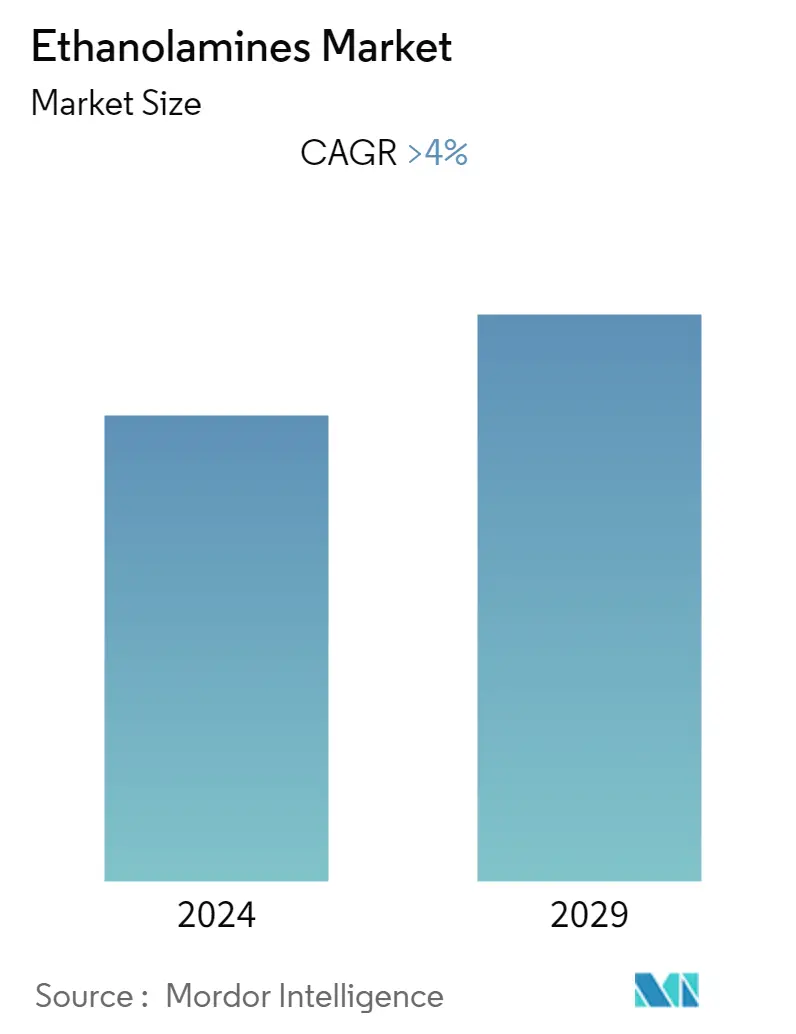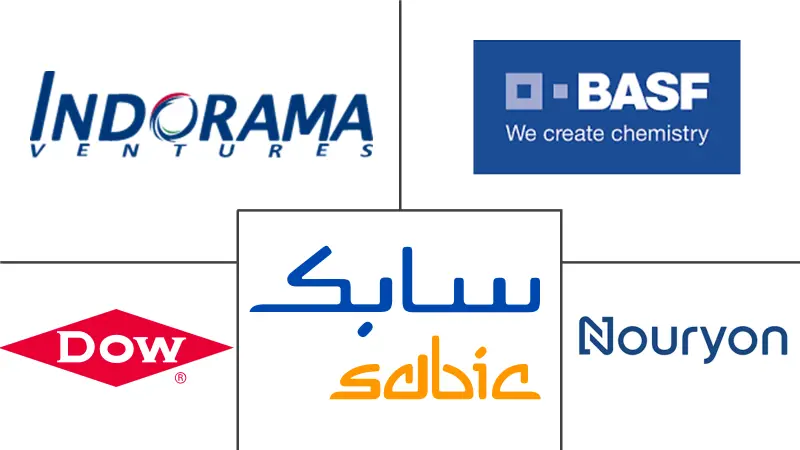Market Size of Ethanolamines Industry

| Study Period | 2019 - 2029 |
| Base Year For Estimation | 2023 |
| CAGR | > 4.00 % |
| Fastest Growing Market | Asia-Pacific |
| Largest Market | Asia-Pacific |
| Market Concentration | Low |
Major Players
*Disclaimer: Major Players sorted in no particular order |
Ethanolamines Market Analysis
During the forecast period, the ethanolamines market is expected to grow at a CAGR of more than 4%.
In 2020, COVID-19 negatively impacted the market. However, the market has now been estimated to have reached pre-pandemic levels and is forecast to grow steadily in the future.
- Growing demand for applications, such as glyphosate herbicides and corrosion inhibitors, for metal protection is likely to drive the market. Furthermore, the increasing use of surfactants is also expected to benefit the market significantly.
- However, rising weed resistance is expected to reduce glyphosate demand and stymie market growth.
The Asia-Pacific region is the biggest market and is expected to grow the fastest over the next few years because countries like China, India, and Japan are using more and more.
Ethanolamines Industry Segmentation
Ethanolamines are colorless, viscous organic compounds used as feedstock in the production of various chemical compounds such as monoethanolamine (MEA), diethanolamines (DEA), and others that are further used in the manufacture of emulsifiers, detergents, pharmaceuticals, and other products. The ethanolamines market is divided into three sections: product type, end-user industry, and geography. By product type, the market is segmented into monoethanolamine, diethanolamine, and triethanolamine. By end-user industry, the market is segmented into agriculture, construction, personal care, oil and gas, metallurgy and metalworking, textiles, and other end-user industries. The report also covers the market size and forecasts for the market in 15 countries across the globe. For each segment, the market sizing and forecasts have been done on the basis of value (USD million).
| Product Type | |
| Monoethanolamine (MEA) | |
| Diethanolamine (DEA) | |
| Triethanolamine (TEA) |
| End-user Industry | |
| Agriculture | |
| Construction | |
| Personal Care | |
| Oil and Gas | |
| Metallurgy and Metalworking | |
| Textile | |
| Other End-user Industries |
| Geography | |||||||
| |||||||
| |||||||
| |||||||
| |||||||
|
Ethanolamines Market Size Summary
The ethanolamines market is poised for steady growth, driven by increasing demand in various applications such as glyphosate herbicides, corrosion inhibitors, and surfactants. The market has rebounded to pre-pandemic levels and is expected to expand at a consistent pace. The Asia-Pacific region, particularly countries like China, India, and Japan, is the largest and fastest-growing market, fueled by rising industrial activities and urbanization. Ethanolamines play a crucial role in metalworking processes, serving as additives in lubricants and metalworking fluids, which are essential for maintaining machinery efficiency and preventing corrosion. The growth in steel production and metalworking activities globally is anticipated to further boost the demand for ethanolamines.
In addition to metalworking, ethanolamines are extensively used in the construction, electronics, and personal care industries. The rapid expansion of the construction sector in China and Japan, driven by urbanization and events like the Olympics and World Expo, is expected to increase the demand for ethanolamines. Similarly, the burgeoning electronics industry in India, supported by favorable government policies, is contributing to the market's growth. The market is characterized by fragmentation, with key players such as BASF SE, Dow, Nouryon, SABIC, and Indorama Ventures Limited actively expanding their production capacities to meet the growing demand. These developments indicate a positive outlook for the ethanolamines market in the coming years.
Ethanolamines Market Size - Table of Contents
-
1. MARKET DYNAMICS
-
1.1 Drivers
-
1.1.1 Rapid Industrialization Across the Globe
-
1.1.2 Growing Construction Activities in the Asia-Pacific Region
-
-
1.2 Restraints
-
1.2.1 Increasing Weed Resistance to Weaken the Demand for Glyphosate
-
-
1.3 Industry Value-chain Analysis
-
1.4 Porter's Five Forces Analysis
-
1.4.1 Bargaining Power of Suppliers
-
1.4.2 Bargaining Power of Consumers
-
1.4.3 Threat of New Entrants
-
1.4.4 Threat of Substitute Products and Services
-
1.4.5 Degree of Competition
-
-
-
2. MARKET SEGMENTATION (Market Size in Value)
-
2.1 Product Type
-
2.1.1 Monoethanolamine (MEA)
-
2.1.2 Diethanolamine (DEA)
-
2.1.3 Triethanolamine (TEA)
-
-
2.2 End-user Industry
-
2.2.1 Agriculture
-
2.2.2 Construction
-
2.2.3 Personal Care
-
2.2.4 Oil and Gas
-
2.2.5 Metallurgy and Metalworking
-
2.2.6 Textile
-
2.2.7 Other End-user Industries
-
-
2.3 Geography
-
2.3.1 Asia-Pacific
-
2.3.1.1 China
-
2.3.1.2 India
-
2.3.1.3 Japan
-
2.3.1.4 South Korea
-
2.3.1.5 Rest of Asia-Pacific
-
-
2.3.2 North America
-
2.3.2.1 United States
-
2.3.2.2 Canada
-
2.3.2.3 Mexico
-
-
2.3.3 Europe
-
2.3.3.1 Germany
-
2.3.3.2 United Kingdom
-
2.3.3.3 Italy
-
2.3.3.4 France
-
2.3.3.5 Rest of Europe
-
-
2.3.4 South America
-
2.3.4.1 Brazil
-
2.3.4.2 Argentina
-
2.3.4.3 Rest of South America
-
-
2.3.5 Middle-East and Africa
-
2.3.5.1 Saudi Arabia
-
2.3.5.2 South Africa
-
2.3.5.3 Rest of Middle-East and Africa
-
-
-
Ethanolamines Market Size FAQs
What is the current Ethanolamines Market size?
The Ethanolamines Market is projected to register a CAGR of greater than 4% during the forecast period (2024-2029)
Who are the key players in Ethanolamines Market?
BASF SE, Dow, Nouryon, SABIC and Indorama Ventures Limited are the major companies operating in the Ethanolamines Market.

